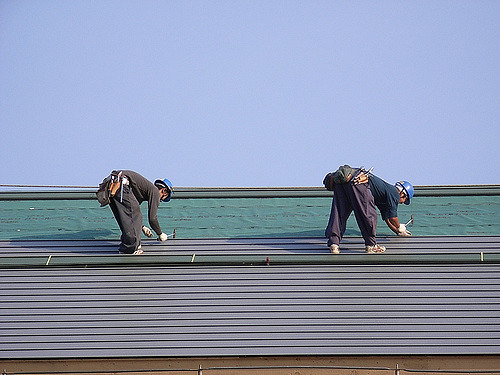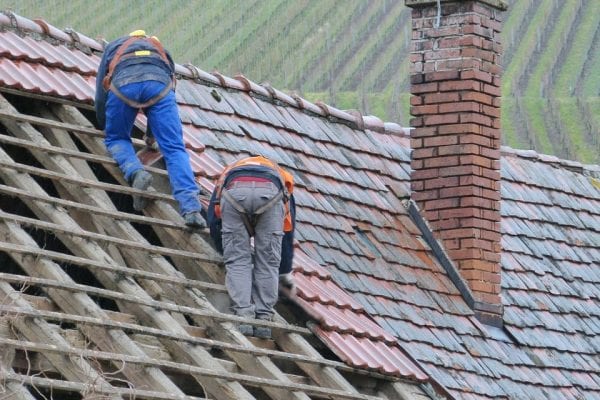Sooner or later, every building, commercial or otherwise, encounters roof problems. This critical element of the building envelope is constantly subjected to weather, debris, and aging, factors that eventually wear down even the highest quality roof. Improper roof installation can accelerate the speed of deterioration.
When leaks or other problems appear, it’s critical to track down the exact cause of the problem, and get it repaired as quickly as possible to prevent further damage to the building. In some cases, it may be necessary to replace all or part of the roof, and in others a repair may be the better choice. In part of that decision, it’s useful to get a general idea of what your repair may cost.
Unfortunately, you can’t expect to get a reliable estimate from an online repair calculator. There are simply too many factors involved, including:
- Leak location
- Type of roof
- Height, pitch, and access
- Type of damage
- Extent of damage
- Geographic location
- Warranty status
Leak Location
It’s only possible to determine if a roof leak is practically repairable, or needs to be replaced, after you’ve identified the source of the leak. More often than not, drawing a line straight up from where the leak appears inside the building will not lead you to the source of the moisture intrusion. Water follows the path of least resistance, and a leak that shows up on the ceiling next to a light fixture may have resulted from a parapet cap leak 50 feet away at an exterior wall. In this case the repair may not only involve repairing the parapet cap, but potentially also replacing water damaged substrate materials between the parapet and the point where the water entered the building. Identifying roof leaks today involves the use of high-technology infrared cameras and moisture meters, operated by experienced professionals, trained in the proper use of the equipment they employ.
Type of Roof
Commercial roofs come in a wide variety of types, divided generally into two broad categories: Flat (low-slope) or sloped. Flat roofs can be less expensive to install, but more expensive to repair. They are also more prone to leaks, because they don’t shed water as readily.
Sloped roofs come in many varieties from inexpensive asphalt shingles to costly clay tile and standing seam metal. Repair labor costs can increase due to the pitch of the roof. The roofing material impacts cost as well, with low cost materials generally being cheaper to repair and more expensive materials generally being more expensive to repair.
Height, Pitch, and Access
The higher the roof, the more expensive it is to get people and materials up there. Also a steeper pitch will increase cost, due to increased risks involved and required safety measures for workers. Easier access will generally decrease the cost of repair, while difficult access will increase it. If a large quantity of repair materials is required, then cost will also be impacted by the availability of easy storage locations and the effort required to transfer materials from ground to roof.
Type of Damage
Roof problems can be caused by wind, impact from storm-driven debris, ice and snow, ordinary wear and tear, or poor installation and materials. The type of problem significantly impacts the cost to repair. The primary types of damage include:
- Damage or seam separation in gutters
- Leaking coping caps or flashing
- Leaking around chimneys, mechanical equipment, roof drains and other roof penetrations
- Dislodged shingles
- Rips or tears in roofing fabric
- Deteriorated or rusted substrate materials
- Damaged trusses or other roof framing components
- Roof pitch failure
When leakage is caused by gutters and flashing, the repair is generally inexpensive. Missing shingles and rips and tears may only require replacement of small portions of the roof. Structural problems such as deteriorating substrate, damaged trusses, and inadequate roof pitch can easily run into the tens or hundreds of thousands to repair and usually will require at least a partial replacement.
Extent of Damage
Generally, damage to a small portion of the roof will cost less to repair than extensive damage such as may be caused by unusually brutal hail storms, extreme wind forces or a bad installation. Sometimes, a relatively inexpensive repair can escalate into a costly repair when repair is delayed and moisture intrusion increases the extent of the damage.
Geographic Location
Labor and material costs vary by location, as do permitting requirements, safety codes, and access. If you’re located in an historic district, or an area where the roof will be exposed to high wind loads, you’ll have additional code considerations. All of these will play a role in the cost of your repair. Also, many local codes allow for lower compliance standards for repairs than for a full replacement.
Some states and municipalities offer incentives for repairing or replacing your roof with energy-efficient materials and technologies, which can reduce your final cost.
Warranty Status
Roof warranties can sometimes reduce your out of pocket cost. Be aware that many warranties only offer prorated reimbursement for repairs, meaning that you’ll only receive reimbursement for a percentage of your repair cost. If your roof is under warranty but nearing the end of the warranty term, it may be cost effective to have the entire roof replaced even if repairs would cost less in the short term.
When estimating the cost to repair or replace your roof, it pays to have a professional examine all of the factors and prepare a cost estimate. An experienced professional will also be able to help you determine whether it will be more cost effective in the long term to invest in a new roof or to go ahead with the repairs. In addition, they can design the project and prepare plans and specifications for bidding to a roofing or general contractor. They can also perform inspections during the construction process, to ensure that your repairs or replacement will provide the long term protection you expect.
Contact GLE today to speak with one of our roofing experts about your building’s roof.






